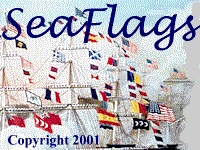
 |
Flags of the U.S. Coast Guard Auxiliary |
On this page:
The U.S. Coast Guard Auxiliary was formed in 1939 to provide a civilian reserve to support the Coast Guard's ability to cope with the boom in recreational boating in the United States. It is an unpaid, voluntary organization of boaters, aircraft owners, and others who make their equipment available to support any of the Coast Guard's statutory missions, focusing particularly on boating safety education and inspections. The basic unit of the auxiliary is the local flotilla, composed of at least 10 vessels. Flotillas are grouped into divisions, which are in turn grouped into districts corresponding to the district structure of the regular Coast Guard.
Boats, aircraft, and radio stations belonging to members of the Coast Guard Auxiliary and meeting standards of equipment and training set forth by the Commandant of the Coast Guard are designated "operational facilities" and authorized to display the Coast Guard Auxiliary ensign. This flag is medium blue with a broad white diagonal band and the Auxiliary emblem in blue and white on the center (33 CFR 5.47). It is known among members as the "blue ensign." It is flown both day and night when the Auxiliarist is aboard, at the main truck if the vessel has a mast or at the bow staff if it does not. Boats equipped with a radio antenna but no mast may fly the Auxiliary ensign on it, about two-thirds of the way up.
When the Coast
Guard takes an Auxiliary member's boat into service for a mission under
Coast Guard orders, the "operational facility" displays the Coast Guard
Auxiliary Patrol Boat ensign, authorized and described by 33 CFR 5.48,
in place of the normal Auxiliary blue ensign. The patrol boat ensign
is based on the so-called "racing stripes" painted as an identifying insignia
on the hulls and fuselages of Coast Guard cutters and aircraft. If
a Coast Guard officer or petty officer is aboard, however, this flag is
replaced by the normal Coast Guard ensign.
Coast Guard Auxiliary officers, who are elected by members to one-year terms of office, fly the pennant of their position day and night when they are on board. Former officers are entitled to fly burgees of the same design, but with parallel upper and lower edges and a swallowtailed fly. If an incumbent officer and a past officer are aboard the same vesel at the same time, the incumbent's pennant takes precedence. Otherwise, if two officers or former officers are aboard at the same time, only the senior's pennant or burgee is flown. The pennant or burgee is normally flown at the starboard yardarm or spreader, if there is one, and otherwise at the bow staff displacing the Auxiliary ensign.
National Commodore |
National Vice Commodore |
|
District Commodore |
District Vice Commodore |
District Rear Commodore
same as District Vice Commodore but blue on white |
Division Captain |
Division Vice Captain |
|
Flotilla Commander |
Flotilla Vice Commander |
Staff officers at various levels fly similar pennants and flags, but with blue devices on a yellow field.
Sea
Flags
Copyright 2000, 2001 by Joseph McMillan